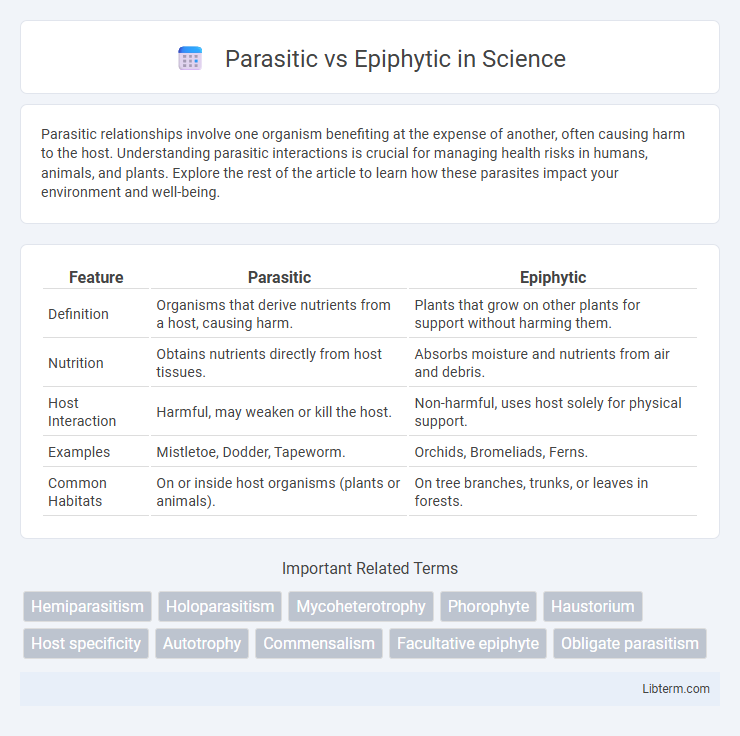Parasitic relationships involve one organism benefiting at the expense of another, often causing harm to the host. Understanding parasitic interactions is crucial for managing health risks in humans, animals, and plants. Explore the rest of the article to learn how these parasites impact your environment and well-being.
Table of Comparison
| Feature | Parasitic | Epiphytic |
|---|---|---|
| Definition | Organisms that derive nutrients from a host, causing harm. | Plants that grow on other plants for support without harming them. |
| Nutrition | Obtains nutrients directly from host tissues. | Absorbs moisture and nutrients from air and debris. |
| Host Interaction | Harmful, may weaken or kill the host. | Non-harmful, uses host solely for physical support. |
| Examples | Mistletoe, Dodder, Tapeworm. | Orchids, Bromeliads, Ferns. |
| Common Habitats | On or inside host organisms (plants or animals). | On tree branches, trunks, or leaves in forests. |
Understanding Parasitic and Epiphytic Relationships
Parasitic relationships involve one organism, the parasite, deriving nutrients at the expense of its host, often causing harm, as seen in mistletoe extracting water and nutrients from trees. Epiphytic relationships feature plants growing on other plants purely for physical support, like orchids on tree branches, without extracting nutrients or harming the host. Understanding these distinctions clarifies ecological roles and adaptations in plant-plant interactions within various ecosystems.
Key Differences Between Parasitic and Epiphytic Organisms
Parasitic organisms derive nutrients directly from their host, often harming the host by extracting water and essential minerals, while epiphytic organisms grow on other plants without extracting nutrients, relying instead on air, rain, and debris for sustenance. Parasitic plants, such as mistletoe and dodder, develop specialized structures like haustoria to penetrate host tissues, whereas epiphytes, including many orchids and bromeliads, possess adaptations for moisture retention and nutrient absorption from the environment. The key difference lies in the parasitic dependence on a host for survival versus the non-parasitic, physical support role of epiphytes.
Types of Parasitic Plants and Examples
Parasitic plants are classified into hemiparasites, which perform photosynthesis and extract water and nutrients from host plants, and holoparasites, which entirely depend on their hosts for sustenance. Common hemiparasitic examples include mistletoe (Viscum album) and Indian paintbrush (Castilleja spp.), whereas holoparasitic plants such as dodder (Cuscuta spp.) and broomrape (Orobanche spp.) lack chlorophyll and rely fully on host plants. These parasitic plants attach to hosts using specialized structures called haustoria, allowing nutrient absorption and often causing significant damage to their hosts.
Common Epiphytic Species Around the World
Common epiphytic species around the world include orchids, bromeliads, and ferns, which thrive by growing on other plants without extracting nutrients from their hosts. These plants absorb moisture and nutrients from the air and rain, enabling them to inhabit diverse ecosystems from tropical rainforests to temperate regions. Unlike parasitic plants such as mistletoe or dodder, epiphytes contribute to biodiversity by providing habitat and supporting complex ecological interactions without harming their supporting plants.
Nutrient Acquisition: Parasitic vs. Epiphytic Strategies
Parasitic plants obtain nutrients by directly tapping into the host plant's vascular system, extracting water and essential minerals to sustain their growth. Epiphytic plants acquire nutrients from the air, rain, and accumulated organic debris, relying on specialized adaptations such as trichomes and modified roots to absorb moisture and mineral salts. These distinct nutrient acquisition strategies reflect evolutionary adaptations that enable survival in competitive or nutrient-poor environments.
Ecological Roles in Their Habitats
Parasitic plants extract water and nutrients directly from their host plants, often weakening or killing them, thus influencing plant community dynamics and nutrient cycling in ecosystems. Epiphytic plants grow non-parasitically on other plants, mainly trees, using them for physical support while obtaining moisture and nutrients from the air and debris, contributing to biodiversity and habitat complexity in forest canopies. Both strategies play crucial ecological roles by shaping species interactions, resource distribution, and overall ecosystem functioning in diverse habitats.
Impact on Host Plants
Parasitic plants, such as mistletoe and dodder, directly harm host plants by extracting water, nutrients, and carbohydrates, weakening their growth and overall health. Epiphytic plants like orchids and bromeliads primarily use hosts for physical support without drawing nutrients, causing minimal or no direct damage to the host. The impact of parasitic plants can lead to reduced photosynthesis and increased susceptibility to disease, whereas epiphytes generally coexist without significantly affecting host vitality.
Adaptations for Survival
Parasitic plants develop specialized structures such as haustoria that penetrate host tissues to extract water and nutrients, ensuring survival in nutrient-poor environments. Epiphytic plants exhibit adaptations like thick, waxy leaves to reduce water loss and extensive root systems that absorb moisture and organic debris from the air and surrounding surfaces. Both strategies maximize resource acquisition in competitive habitats, enhancing their ecological success without relying on soil nutrients.
Importance in Biodiversity and Ecosystems
Parasitic plants, such as mistletoe, play a crucial role in biodiversity by regulating host populations and creating niches for various species, thus enhancing ecosystem complexity. Epiphytic plants, like orchids and bromeliads, contribute significantly to ecosystem diversity by providing habitat and resources for numerous animals and microorganisms without harming their host plants. Both parasitic and epiphytic species maintain ecological balance, promoting species interactions and facilitating nutrient cycling in forest ecosystems.
Conservation and Human Interactions
Parasitic plants, which extract nutrients directly from host plants, often pose challenges for conservation as they can threaten the survival of endangered species and disrupt native ecosystems. Epiphytic plants, growing non-parasitically on other plants for support, contribute to biodiversity by providing habitats and food sources for insects and birds without harming their hosts. Conservation efforts prioritize maintaining the balance between parasitic and epiphytic species to protect ecosystem health and support sustainable human activities such as agriculture and horticulture.
Parasitic Infographic

 libterm.com
libterm.com